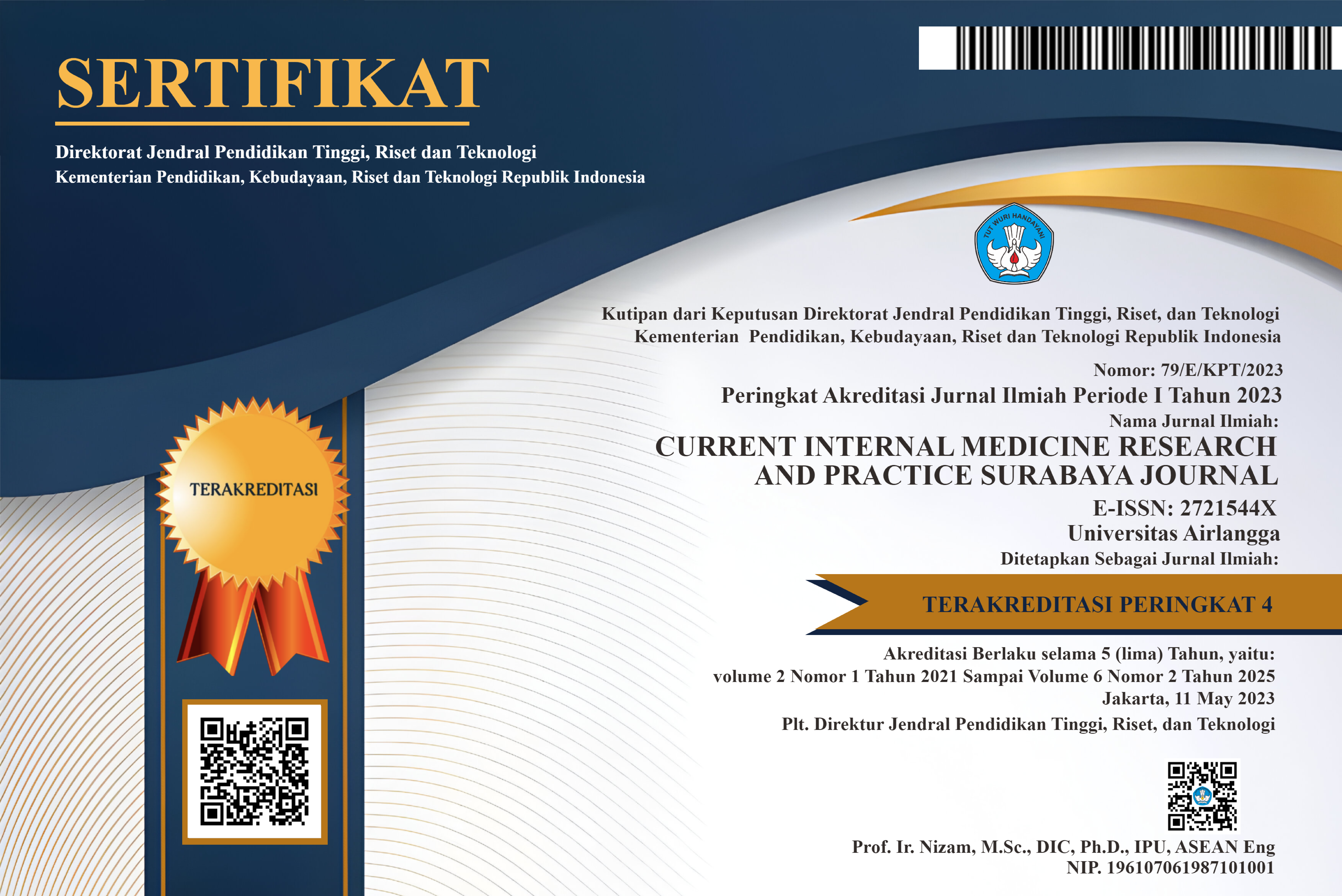Lupus Nephritis: A Literature Review
Downloads
Systemic lupus erythematosus (SLE) has diverse clinical presentations, including lupus nephritis (LN), if LN manifest the mortality & morbidity will be elevated. The majority of SLE cases found in females, especially during puberty and childbearing age. A comprehensive understanding of the epidemiology, classification, diagnosis, and management of LN is essential for medical practitioners. Initially, the diagnostic process requires clinical examinations to find clinical manifestations. This process then followed by laboratory assessments to diagnose SLE and identify any indication related to kidney damage, commonly proteinuria. Other findings such as haematuria and leukocyturia may also present. Antinuclear antibodies (ANA) test and anti-dsDNA serves as primary diagnostic tool. In addition, kidney biopsy is the gold standard for LN due to its ability to confirm and measure the stadium for treatment guide. The therapy is specifically based on clinical and biopsy findings, categorized by World Health Organization (WHO) into five classes, namely normal, mesangial, focal and segmental proliferative, diffuse proliferative, and membranous. Accurate diagnosis in the initial stage and suitable therapy is crucial to significantly improve the prognosis of LN. In this review, we address some clinical manifestations related to LN and standardised diagnostic assessment tools, with an ultimate goal to improve the outcome of patients with lupus through an individual-specific management.
Almaani, S., Meara, A., et al 2017. Update on lupus nephritis. Clinical Journal of the American Society of Nephrology, 12(5). DOI 10.2215/CJN.05780616
Arkema, E.V., Saleh, M., et al. 2023. Epidemiology and Damage Accrual of Systemic Lupus Erythematosus in Central Sweden: A Single-Center Population-Based Cohort Study Over 14 Years From Östergötland County. ACR Open Rheumatology, [online] 5(8), 426–432. DOI: 10.1002/acr2.11585.
Diagne, S., Keita, N., Tall, A.L., Ba, B., Faye, M., Faye, M., Fall, K., Mbengue, M., Dieng, A., Ba, M.A., Cisse, M.M., Ka, E.H.F. and Niang, A. 2020. Sun-428 Lupus Nephritis at Aristide Le Dantec University Hospital In Dakar (Senegal) about 99 Cases: Histopathological, Therapeutic, Pronostic And Evolutive Aspects. Kidney International Reports, [online] 5(3, Supplement), pp.S373–S374. DOI :https://doi.org/10.1016/j.ekir.2020.02.968.
Fanouriakis, A., Tziolos, N., Bertsias, G. and Boumpas, D.T. 2020. Update Οn the Diagnosis and Management of Systemic Lupus Erythematosus. Annals of the Rheumatic Diseases, 80(1), p.annrheumdis-2020-218272. DOI: 10.1136/annrheumdis-2020-218272.
Hailu, G.-M.T., Hussen, S.U., Getachew, S. and Berha, A.B. (2022). Management practice and treatment outcomes of adult patients with Lupus Nephritis at the Renal Clinic of St. Paul's Hospital Millennium Medical College, Addis Ababa, Ethiopia. BMC Nephrology, [online] 23(1). doi:https://doi.org/10.1186/s12882-022-02846-z.
Hocaoglu, M., Valenzuela-Almada, et al. 2022. Incidence, Prevalence, and Mortality of Lupus Nephritis: A Population-Based Study Over Four Decades”The Lupus Midwest Network (LUMEN). Arthritis & Rheumatology. DOI:10.1002/art.42375.
Jorgensen, T.N., Perl, A.et al. 2022. New Biomarkers for the Diagnosis and Treatment of Systemic Lupus Erythematosus. Frontiers Media SA . DOI.10.3389/fimmu.2022.1009038
Justiz Vaillant, Goyal, A., et al. 2020. Lupus Erythematosus. [online] PubMed. Available at: https://www.ncbi.nlm.nih.gov/books/NBK535405/.
KDIGO. 2023. Clinical Practice Guideline for the Management of Lupus Nephritis Public Review Draft.
Rovin, B.H., Adler, S.G., Barratt, J., Bridoux, F., Burdge, K.A., Chan, T.M., Cook, H.T., Fervenza, F.C., Gibson, K.L., Glassock, R.J., Jayne, D.R.W., Jha, V., Liew, A., Liu, Z.-H., Mejía-Vilet, J.M., Nester, C.M., Radhakrishnan, J., Rave, E.M., Reich, H.N. and Ronco, P. 2021. Executive summary of the KDIGO 2021 Guideline for the Management of Glomerular Diseases. Kidney International, [online] 100(4), pp.753–779. DOI: https://doi.org/10.1016/j.kint.2021.05.015.
Kuhn, A., Landmann, A. (2022). Systemic lupus erythematosus. European Handbook of Dermatological Treatments, Third Edition, 547–560. DOI: 10.1007/978-3-662-45139-7_55
Indonesian Rheumatology Association (IRA). 2019. Diagnosis dan Pengelolaan Lupus Eritematosus Sistemik. Jakarta: IRA, p 59-65
Moe, S.E.R., Molberg, et al. 2019. Assessing the relative impact of lupus nephritis on mortality in a population-based systemic lupus erythematosus cohort. Lupus, 28(7), 818–825. DOI:10.1177/0961203319847275.
Musa, R., Brent, L.H., et al. 2023. Lupus Nephritis. Treasure Island, Florida: StatPearls Publishing. [online] https://www.ncbi.nlm.nih.gov/books/NBK499817/?report=reader#_NBK499817_pubdet_
Perl, A., Agmon"Levin, N.,Crispín, J.C. and Jí¸rgensen, T.N. 2022. Editorial: New biomarkers for the diagnosis and treatment of systemic lupus erythematosus. Frontiers in Immunology, 13. DOI:0.3389/fimmu.2022.1009038.
Pisetsky, D.S. and Lipsky, P.E. 2020. New insights into the role of antinuclear antibodies in systemic lupus erythematosus. Nature Reviews Rheumatology, [online] 16(10), pp.565–579. DOI:10.1038/s41584-020-0480-7.
Singh, J., Hossain, A., Kotb, A., Oliveira, A., Mudano, A., Grossman, J., Winthrop, K., Wells, G., Singh, J. and Winthrop, F. 2016. Treatment for Lupus Nephritis: A Systemic Review and Network Metaanalysis. The Journal of Rheumatology, [online] 43(10), pp.1801–1816. 10.3899/jrheum.160041
Singh, R.R., Yen, E.Y. 2018. SLE mortality remains disproportionately high, despite improvements over the last decade. Lupus, 27(10), 1577–1581. DOI:10.1177/0961203318786436.
Suárez-Fueyo, A., Bradley, S.J. 2016. T cells in Systemic Lupus Erythematosus. Current Opinion in Immunology, 43, pp.32–38. DOI:10.1016/j.coi.2016.09.001.
Tan, T.C., Fang, H., et al. 2012. Differences between Male and Female Systemic Lupus Erythematosus in a Multiethnic Population. The Journal of Rheumatology, [online] 39(4), 759–769. DOI:10.3899/jrheum.111061.
Touma, Z., Urowitz, M.B., et al. 2014. Time to Recovery from Proteinuria in Patients with Lupus Nephritis Receiving Standard Treatment. The Journal of Rheumatology, [online] 41(4), pp.688–697. doi:10.3899/jrheum.130005
Tsai, H.-L., Chang, J.-W., et al. 2022. Epidemiology and risk factors associated with avascular necrosis in patients with autoimmune diseases: a nationwide study. The Korean Journal of Internal Medicine. DOI:10.3904/kjim.2020.098.
Yap, D.Y.H. and Chan, T.M. 2019. B Cell Abnormalities in Systemic Lupus Erythematosus and Lupus Nephritis”Role in Pathogenesis and Effect of Immunosuppressive Treatments. International Journal of Molecular Sciences, 20(24), p.6231. DOI:10.3390/ijms20246231.
Zubair, A., Frieri, M. 2013. Lupus Nephritis: Review of the Literature Current Allergy and Asthma Reports, 13(6), 580–586. DOI:10.1007/s11882-013-0394-4.
Copyright (c) 2024 Bestri Fortuna, Awalia, Puspa Wardhani

This work is licensed under a Creative Commons Attribution-ShareAlike 4.0 International License.
Copyright (c) Author
1. The journal allows the author to hold the copyright of the article without restrictions.
2. The journal allows the author(s) to retain publishing rights without restrictions.
3. The formal legal aspect of journal publication accessibility refers to Creative Commons Atribution-Share Alike 4.0 (CC BY-SA).






















